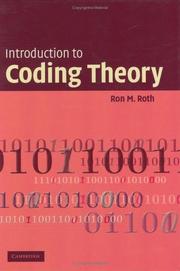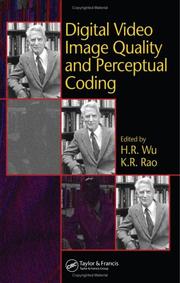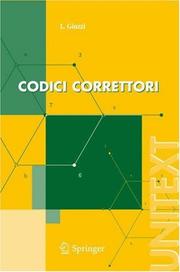| Listing 1 - 10 of 174 | << page >> |
Sort by
|
Book
ISBN: 1280614145 9786610614141 2287304894 Year: 2006 Publisher: Paris : Springer,
Abstract | Keywords | Export | Availability | Bookmark
 Loading...
Loading...Choose an application
- Reference Manager
- EndNote
- RefWorks (Direct export to RefWorks)
Le système TNM constitue la classification la plus largement utilisée pour décrire la croissance et l'extension des tumeurs malignes. Cette classification apporte une aide considérable au clinicien dans la définition de son pronostic et l'établissement de son planning de soin. Elle permet une évaluation plus précise des résultats du traitement préconisé. Elle facilite les échanges d'information entre les centres anticancéreux et contribue à la poursuite des recherches en cancérologie. L'Atlas TNM est conçu comme un outil pratique pour l'application du système de classification TNM.
Tumors --- Cancer --- Oncology --- Tumor coding --- Staging
Book
ISBN: 0131981994 Year: 2006 Publisher: London Pearson/Prentice Hall
Abstract | Keywords | Export | Availability | Bookmark
 Loading...
Loading...Choose an application
- Reference Manager
- EndNote
- RefWorks (Direct export to RefWorks)
Computer science --- Computer architecture. Operating systems --- Coding theory. --- Cryptography.

ISBN: 0521845041 9780521845045 9780511808968 Year: 2006 Publisher: Cambridge: Cambridge university press,
Abstract | Keywords | Export | Availability | Bookmark
 Loading...
Loading...Choose an application
- Reference Manager
- EndNote
- RefWorks (Direct export to RefWorks)
Error-correcting codes constitute one of the key ingredients in achieving the high degree of reliability required in modern data transmission and storage systems. This book introduces the reader to the theoretical foundations of error-correcting codes, with an emphasis on Reed-Solomon codes and their derivative codes. After reviewing linear codes and finite fields, Ron Roth describes Reed-Solomon codes and various decoding algorithms. Cyclic codes are presented, as are MDS codes, graph codes, and codes in the Lee metric. Concatenated, trellis, and convolutional codes are also discussed in detail.
Coding theory. --- 681.3.041 --- Computer science--?.041 --- Coding theory --- Data compression (Telecommunication) --- Digital electronics --- Information theory --- Machine theory --- Signal theory (Telecommunication) --- Computer programming
Book
ISBN: 0769526357 1509096108 9781509096107 Year: 2006 Publisher: [Place of publication not identified] IEEE Computer Society
Abstract | Keywords | Export | Availability | Bookmark
 Loading...
Loading...Choose an application
- Reference Manager
- EndNote
- RefWorks (Direct export to RefWorks)
Multimedia systems --- Information technology --- Computer networks --- Coding theory --- Engineering & Applied Sciences --- Computer Science
Book
Year: 2006 Publisher: Rockville, MD : U.S. Dept. of Health and Human Services, Food and Drug Administration, Center for Drug Evaluation and Research : Center for Biologics Evaluation and Research,
Abstract | Keywords | Export | Availability | Bookmark
 Loading...
Loading...Choose an application
- Reference Manager
- EndNote
- RefWorks (Direct export to RefWorks)
Bar coding --- Drugs --- Biological products --- Government policy --- Labeling --- Center for Drug Evaluation and Research (U.S.)

ISBN: 0470010118 9780470010112 Year: 2006 Publisher: Chichester Wiley
Abstract | Keywords | Export | Availability | Bookmark
 Loading...
Loading...Choose an application
- Reference Manager
- EndNote
- RefWorks (Direct export to RefWorks)
Rik Van de Walle is the first to document MPEG-21, a current & hot topic', which is stimulating interest in the multimedia community and quickly becoming a standardized technology. Multimedia technology provides the different players in the value and delivery chain with an excess of information and services. However, no complete solutions exist that allow different communities (content, financial, communication, computer and consumer electronics and their customers), each with their own models, rules, procedures, interests and content formats, to interact efficiently using this complex infrastructure. Developing a common (big picture) MPEG-21 multimedia framework would facilitate co-operation between sectors and support a more efficient implementation and integration of the different models, resulting in an enhanced user experience. Thus, MPEG-21, the multimedia framework, seeks to fill the gaps and create the big picture of multimedia standards. It aims to guarantee interoperability by focusing on how the elements of a multimedia application infrastructure should relate, integrate and interact. Finally, where open standards for elements are missing, MPEG-21 is providing new technologies to fill the gaps. Serving as a timely and important reference for a burgeoning market, this indispensable text is edited by multimedia experts and_is an_invaluable_reference for_all those in the industry. MPEG-21 guarantees interoperability between multimedia systems by focusing on the elements of a multimedia application infrastructure. Presents a comprehensive overview of the technical issues, which MPEG-21 has standardised including, DID (Digital Item Declaration), DII (Digital Item Identification) and file format and those already in a mature state (e.g. MPEG-21 Digital Item Adaption). First book to deal with MPEG-21, which is a hot multimedia topic. Gained significant interest from the multimedia community. Includes chapters by leading experts in the field who have contr
Computer animation --- Digital video. --- MPEG (Video coding standard). --- Standards. --- Digital video --- MPEG (Video coding standard) --- Motion Picture Experts Group standard --- Video compression --- Digital motion video --- PC video --- Video, Digital --- Computer graphics --- Digital media --- Image processing --- Multimedia systems --- Standards --- Digital techniques

Abstract | Keywords | Export | Availability | Bookmark
 Loading...
Loading...Choose an application
- Reference Manager
- EndNote
- RefWorks (Direct export to RefWorks)
This book addresses the issue of human visual system (HVS)-based perceptual quantitative quality metrics for digitally coded image and video as well as the issue of perceptual image and video coding. Introducing basic techniques, the text presents standard and popular coding structures, gives a classification and analysis of various coding artifacts, and provides performance measures. It further discusses subjective assessment methods, quantitative quality metrics, test criteria, and procedures. There is additional coverage on HVS-based digital image and video coder designs, including new perceptual coders and post-filtering techniques. The authors highlight critical challenges facing future research.
coderen --- digitale video --- Artificial intelligence. Robotics. Simulation. Graphics --- Coding theory. --- Computer vision. --- Digital video. --- Imaging systems --- Perception. --- Image quality.

ISBN: 012620862X 9780126208627 9786611227319 1281227315 0080509258 9780080509259 9781281227317 6611227318 Year: 2006 Publisher: Amsterdam, [Netherlands] : Morgan Kaufmann,
Abstract | Keywords | Export | Availability | Bookmark
 Loading...
Loading...Choose an application
- Reference Manager
- EndNote
- RefWorks (Direct export to RefWorks)
Each edition of Introduction to Data Compression has widely been considered the best introduction and reference text on the art and science of data compression, and the third edition continues in this tradition. Data compression techniques and technology are ever-evolving with new applications in image, speech, text, audio, and video. The third edition includes all the cutting edge updates the reader will need during the work day and in class. Khalid Sayood provides an extensive introduction to the theory underlying today's compression techniques with detailed instruction for their app
Coding theory --- Data compression (Telecommunication) --- 681.3*E4 --- Compression of data (Telecommunication) --- Data compression (Computer science) --- Data transmission systems --- Digital electronics --- Information theory --- Machine theory --- Signal theory (Telecommunication) --- Computer programming --- 681.3*E4 Coding and information theory: data compaction and compression; formal modelsof communication; nonsecret encoding schemes--See also {681.3*H11} --- Coding and information theory: data compaction and compression; formal modelsof communication; nonsecret encoding schemes--See also {681.3*H11} --- Coding theory.

ISBN: 884700540X 8847005396 Year: 2006 Volume: 27 Publisher: Milano : Springer Milan : Imprint: Springer,
Abstract | Keywords | Export | Availability | Bookmark
 Loading...
Loading...Choose an application
- Reference Manager
- EndNote
- RefWorks (Direct export to RefWorks)
L'obiettivo della teoria dei codici è quello di studiare metodi per comunicare in modo affidabile, pur in presenza di disturbi. Essa si è rivelata strumento indispensabile per la realizzazione di sistemi di comunicazione digitale e, pertanto, il suo studio riveste notevole interesse pratico. In questo testo testo, destinato a studenti dei corsi di laurea di primo (II/III anno) e secondo livello in matematica, fisica o ingegneria, vengono introdotte le famiglie classiche di codici correttori di errore e si mostra come esse possano essere concretamente applicate per comunicare; si presentano inoltre anche alcune famiglie di codici di più recente scoperta, attualmente oggetto di intensa attività di ricerca.
Coding theory. --- Data compression (Telecommunication) --- Digital electronics --- Information theory --- Machine theory --- Signal theory (Telecommunication) --- Computer programming --- Geometry. --- Mathematics --- Euclid's Elements
Book
ISBN: 0769523544 1509097929 Year: 2006 Publisher: New York : IEEE,
Abstract | Keywords | Export | Availability | Bookmark
 Loading...
Loading...Choose an application
- Reference Manager
- EndNote
- RefWorks (Direct export to RefWorks)
Software maintenance --- Computer programming --- Computers --- Electronic computer programming --- Electronic data processing --- Electronic digital computers --- Programming (Electronic computers) --- Coding theory --- Management --- Programming
| Listing 1 - 10 of 174 | << page >> |
Sort by
|

 Search
Search Feedback
Feedback About UniCat
About UniCat  Help
Help News
News